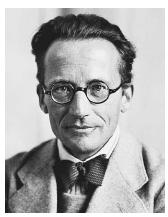Erwin Schrödinger
AUSTRIAN THEORETICAL PHYSICIST
1887–1961
Erwin Schrödinger was born in Vienna, Austria, in 1887. In 1906 he entered the University of Vienna with the intention of studying statistical thermodynamics with the mathematician and physicist Ludwig Boltzmann. Unfortunately it was the year Boltzmann committed suicide, and Schrödinger studied under Boltzmann's successor, Fritz Hasenöhrl. Schrödinger received his doctorate in 1910 for a dissertation on electrical conduction. The next four years were spent as an assistant instructor in experimental physics at the University of Vienna. In 1914 he was drafted to serve in the Austro-Hungarian army and fought on the side of Germany during World War I. In 1917 he returned to his former position in Vienna. In the aftermath of several research successes, Schrödinger found himself to be in great demand, and he accepted, one right after the other, faculty positions at the Universities of Jena, Stuttgart, and Breslau. Finally, in late 1921 he accepted the chair in theoretical physics at the University of Zurich (in Switzerland). Although his stay there was relatively short (six years), it was there that he published his most significant work—in quantum statistics, the dynamics of crystal lattices, the theory of color vision, and quantum theory.
Schrödinger's work in quantum theory resulted in the creation of a new scientific discipline—wave mechanics, which has as its centerpiece the Schrödinger wave equation, explained in a series of four papers published in 1926. This equation and the later relativistic versions are considered by many scientists to have the same central importance to molecular quantum mechanics as Newton's laws of motion have to large-scale classical mechanics.

Schrödinger began to search for a wave equation in 1925 after reading a paper by Albert Einstein about Louis de Broglie's ideas that matter could possess both wave and particle properties simultaneously, as expressed in the de Broglie equation relating the wavelength of a matter wave to its momentum. Schrödinger demonstrated that the de Broglie equation could be generalized so as to apply to particles such as electrons in atoms. The Schrödinger equation is a wave equation that explains the properties and behavior of all types of submicroscopic particles with small masses and that are in the presence of electric and magnetic fields. Schrödinger's work was immediately accepted worldwide, and he received a call to accept the challenge of succeeding Max Planck in the department of theoretical physics at the University of Berlin. He stayed until 1933, but by that time he had become so outraged by the German government's treatment of Jewish scientists that he accepted a position at Oxford University in England, just before he was informed that he had been awarded the 1933 Nobel Prize in physics for his development of wave mechanics. For the next seven years (during which time a return to Vienna would have been most difficult), he accepted several temporary appointments. In 1941 he became director of the School of Theoretical Physics at the Dublin Institute for Advanced Studies (in Ireland). There he worked mainly on unified field theory.
He also published a number of books. Of these, What Is Life? The Physical Aspect of the Living Cell is credited with having persuaded physicists to take an interest in the problems of biology. It is also credited with having attracted many young people to the new field of molecular biology. For instance, James Watson, one of the discoverers of the structure and function of DNA , stated that, from the moment he read the book, he "became polarized toward finding out the secret of the gene."
In 1955 Austria became free of Soviet occupation, and Schrödinger returned to the University of Vienna, where he received many honors as Austria's greatest living scientist. Schrödinger retired in 1958 and died in 1961.
SEE ALSO DE Broglie, Louis ; Quantum Chemistry ; Watson, James Dewey .
John E. Bloor
Bibliography
McMurray, Emily J., ed. (1995). Notable Twentieth-Century Scientists. Detroit: Gale Research.
Mehra, Jagdish, and Rechenberg, Helmut (1987). The Historical Development of Quantum Theory, Vol. 5. Part 2: The Creation of Wave Mechanics; Early Response and Applications, 1925–1926. New York: Springer-Verlag.
Moore, Walter (1994). A Life of Erwin Schrödinger. New York: Cambridge University Press.
Comment about this article, ask questions, or add new information about this topic: